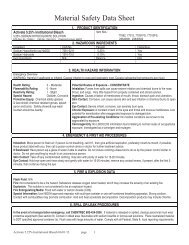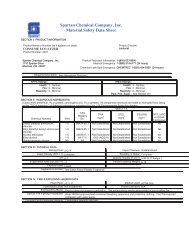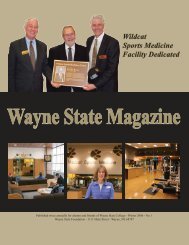Lacquer Thinner MATERIAL SAFETY DATA SHEET 1. Product and ...
Lacquer Thinner MATERIAL SAFETY DATA SHEET 1. Product and ...
Lacquer Thinner MATERIAL SAFETY DATA SHEET 1. Product and ...
- No tags were found...
You also want an ePaper? Increase the reach of your titles
YUMPU automatically turns print PDFs into web optimized ePapers that Google loves.
<strong>MATERIAL</strong> <strong>SAFETY</strong> <strong>DATA</strong> <strong>SHEET</strong><strong>Lacquer</strong> <strong>Thinner</strong>Page:1<strong>Product</strong> Code: 1605.46<strong>Product</strong> Name:<strong>Lacquer</strong> <strong>Thinner</strong>Manufacturer InformationCompany Name:FlammabilityHealth23Instability0Special<strong>1.</strong> <strong>Product</strong> <strong>and</strong> Company IdentificationW. M. Barr2105 Channel AvenueMemphis, TN 38113Phone Number: (901)775-0100Emergency Contact: 3E 24 Hour Emergency Contact (800)451-8346Information: W.M. Barr Customer Service (800)398-3892Web site address:www.wmbarr.comPreparer Name: W.M. Barr EHS Dept (901)775-0100Intended Use:Paint thinning <strong>and</strong> general paint clean up.SynonymsGML170, QML170, CML170, QML170L2. Hazards IdentificationPrinted: 05/21/2009Revision: 05/21/2009Supercedes Revision: 04/09/2009Date Created: 08/20/2007Emergency OverviewDanger! Extremely flammable. Keep away from heat, sparks, flame <strong>and</strong> all other sources of ignition. Vaporsmay cause flash fire or ignite explosively. Do not smoke. Extinguish all flames <strong>and</strong> pilot lights, <strong>and</strong> turn offstoves, heaters, electric motors <strong>and</strong> all other sources of ignition during use <strong>and</strong> until all vapors are gone. Bewareof static electricity that may be generated by clothing <strong>and</strong> other sources.OSHA Regulatory Status:This material is classified as hazardous under OSHA regulations.Health Hazards (Acute <strong>and</strong> Chronic)Inhalation Acute Exposure Effects:Vapor harmful. May cause dizziness; headache; watering of eyes; irritation of respiratory tract; weakness;drowsiness; nausea; numbness in fingers, arms <strong>and</strong> legs; depression of central nervous system; loss of appetite;fatigue; hallucinations; light headedness; visual disturbances; giddiness <strong>and</strong> intoxication; sleepiness; cough <strong>and</strong>dyspnea; cold, clammy extremities; diarrhea; vomiting; dilation of pupils; spotted vision. Severe overexposuremay cause convulsions; unconsciousness; coma; <strong>and</strong> death. Intentional misuse of this product by deliberatelyconcentrating <strong>and</strong> inhaling can be harmful or fatal.Skin Contact Acute Exposure Effects:May be absorbed through the skin. May cause irritation; numbness in the fingers <strong>and</strong> arms; drying of skin; <strong>and</strong>dermatitis. May cause increased severity of symptoms listed under inhalation.Eye Contact Acute Exposure Effects:This material is an eye irritant. May cause irritation; burns; conjunctivitis of eyes; <strong>and</strong> corneal ulcerations of theeye. Vapors may irritate eyes.Ingestion Acute Exposure Effects:Poison. Cannot be made non-poisonous. May be fatal or cause blindness. May cause dizziness; headache;nausea; vomiting; burning sensation in mouth, throat, <strong>and</strong> stomach; loss of coordination; depression of the centralnervous system; narcosis; stupor; gastrointestinal irritation; liver, kidney, <strong>and</strong> heart damage; diarrhea; loss ofLicensed to W.M. Barr <strong>and</strong> CompanyGHS format
<strong>MATERIAL</strong> <strong>SAFETY</strong> <strong>DATA</strong> <strong>SHEET</strong><strong>Lacquer</strong> <strong>Thinner</strong>appetite; coma <strong>and</strong> death. May produce symptoms listed under inhalation.Page: 2Printed: 05/21/2009Revision: 05/21/2009Supercedes Revision: 04/09/2009Chronic Exposure Effects:Reports have associated repeated <strong>and</strong> prolonged overexposure to solvents with neurological <strong>and</strong> otherphysiological damage. Prolonged or repeated contact may cause dermatitis. Prolonged skin contact may result inabsorption of a harmful amount of this material. May cause conjunctivitis; gastric disturbances; insomnia;dizziness; headache; weakness; fatigue; nausea; heart palpitations; skin irritation; numbness in h<strong>and</strong>s <strong>and</strong> feet;permanent central nervous system changes; some loss of memory; pancreatic damage; giddiness; visualimpairment or blindness; kidney or liver damage; <strong>and</strong> death. May cause symptoms listed under inhalation.Target Organs: Central Nervous System, Liver, Kidney, Heart, Stomach, Respiratory SystemPrimary Routes of Entry: Inhalation, Ingestion, Skin AbsorptionSigns <strong>and</strong> Symptoms Of ExposureSee Potential Health Effects.Medical Conditions Generally Aggravated By ExposureDiseases of the skin, eyes, liver, kidneys, central nervous system <strong>and</strong> respiratory system.Hazardous Components (Chemical Name)<strong>1.</strong> Methanol {Methyl alcohol; Carbinol; Woodalcohol}2.3.4.5.6.7.3. Composition/Information on IngredientsCAS #67-56-1Concentration10.0 -30.0 %Toluene {Benzene, Methyl-; Toluol} 108-88-3 5.0 -60.0 %Acetone 67-64-1 7.0 -13.0 %Methyl ethyl ketone {MEK; 2-Butanone} 78-93-3 <strong>1.</strong>0 -15.0 %Ethanol, 2-Butoxy- {Ethylene glycol n-butyl111-76-2 <strong>1.</strong>0 -5.0 %ether, (a glycol ether)}Acetic acid, Ethyl ester {Ethyl acetate} 141-78-6 0.5 -15.0 %Hexane, Light aliphatic naptha {Light aliphatic 64742-89-8 <strong>1.</strong>0 -39.0 %solvent naphtha (petroleum)}4. First Aid MeasuresEmergency <strong>and</strong> First Aid ProceduresInhalation:If user experiences breathing difficulty, move to air free of vapors, Administer oxygen or artificial medicalassistance can be rendered.Skin Contact:Wash with soap <strong>and</strong> large quantities of water <strong>and</strong> seek medical attention if irritation from contact persists.Eye Contact:Flush with large quantities of water for at least 15 minutes <strong>and</strong> seek immediate medical attention.Ingestion:Call your local poison control center, hospital emergency room or physician immediately for instructions toinduce vomiting.Note to PhysicianPoison. This product contains methanol. Methanol is metabolized to formaldehyde <strong>and</strong> formic acid. Thesemetabolites may cause metabolic acidosis, visual disturbances <strong>and</strong> blindness. Since metabolism is required forthese toxic symptoms, their onset may be delayed from 6 to 30 hours following ingestion. Ethanol competes forthe same metabolic pathway <strong>and</strong> has been used as an antidote. Methanol is effectively removed by hemodialysis.Call your local poison control center for further information.Licensed to W.M. Barr <strong>and</strong> CompanyGHS format
<strong>MATERIAL</strong> <strong>SAFETY</strong> <strong>DATA</strong> <strong>SHEET</strong><strong>Lacquer</strong> <strong>Thinner</strong>5. Fire Fighting MeasuresPage:Printed: 05/21/2009Revision: 05/21/2009Supercedes Revision: 04/09/2009Flammability Classification: NFPA Class IBFlash Pt: < 20.00 F Method Used: Setaflash Closed Cup (Rapid Setaflash)Explosive Limits: LEL: No data. UEL: No data.Special Fire Fighting ProceduresSelf-contained respiratory protection should be provided for fire fighters fighting fires in buildings or confinedareas. Storage containers exposed to fire should be kept cool with water spray to prevent pressure build-up. Stayaway from heads of containers that have been exposed to intense heat or flame.Unusual Fire <strong>and</strong> Explosion HazardsNo data available.Hazardous Combustion <strong>Product</strong>sCarbon monoxide <strong>and</strong> carbon dioxide.Suitable Extinguishing MediaUse carbon dioxide, dry powder, or foam.Unsuitable Extinguishing MediaNo data available.6. Accidental Release MeasuresSteps To Be Taken In Case Material Is Released Or SpilledClean up:3Keep unnecessary people away; isolate hazard area <strong>and</strong> deny entry. Stay upwind, out of low areas, <strong>and</strong> ventilateclosed spaces before entering. Shut off ignition sources; keep flares, smoking or flames out of hazard area.Small spills:Take up with s<strong>and</strong>, earth or other noncombustible absorbent material <strong>and</strong> place in a plastic container whereapplicable.Large spills:Dike far ahead of spill for later disposal.7. H<strong>and</strong>ling <strong>and</strong> StoragePrecautions To Be Taken in H<strong>and</strong>lingRead carefully all cautions <strong>and</strong> directions on product label before use. Since empty container retains residue,follow all label warnings even after container is empty. Dispose of empty container according to all regulations.Do not reuse this container.Do not use in small enclosed spaces, such as basements <strong>and</strong> bathrooms. Vapors can accumulate <strong>and</strong> explode ifignited.Precautions To Be Taken in StoringKeep container tightly closed when not in use. Store in a cool, dry place. Do not store near flames or at elevatedtemperatures.Licensed to W.M. Barr <strong>and</strong> CompanyGHS format
Hazardous Components (Chemical Name)<strong>1.</strong> Methanol {Methyl alcohol; Carbinol; Woodalcohol}2.3.4.5.6.7.<strong>MATERIAL</strong> <strong>SAFETY</strong> <strong>DATA</strong> <strong>SHEET</strong><strong>Lacquer</strong> <strong>Thinner</strong>8. Exposure Controls/Personal ProtectionPEL: 200 ppmTLV: 200 ppmSTEL: 250 ppmPage:Printed: 05/21/2009Revision: 05/21/2009Supercedes Revision: 04/09/2009CAS # OSHA TWA ACGIH TWAOther Limits67-56-1Toluene {Benzene, Methyl-; Toluol} 108-88-3Acetone 67-64-1Methyl ethyl ketone {MEK; 2-Butanone} 78-93-3Ethanol, 2-Butoxy- {Ethylene glycol n-butylether, (a glycol ether)}111-76-2Acetic acid, Ethyl ester {Ethyl acetate} 141-78-6Hexane, Light aliphatic naptha {Light aliphaticsolvent naphtha (petroleum)}64742-89-8PEL: 200 ppmSTEL: 500 ppm/(10min)CEIL: 300 ppmPEL: 1000 ppmPEL: 200 ppmPEL: 50 ppmPEL: 400 ppmNo data.TLV: 50 ppmTLV: 500 ppmSTEL: 750 ppmTLV: 200 ppmSTEL: 300 ppmTLV: 20 ppmTLV: 400 ppmNo data.No data.No data.No data.No data.No data.No data.No data.Respiratory Equipment (Specify Type)For OSHA controlled work place <strong>and</strong> other regular users. Use only with adequate ventilation under engineeredair control systems designed to prevent exceeding appropriate TLV.4For occasional use, where engineered air control is not feasible, use properly maintained <strong>and</strong> properly fittedNIOSH approved respirator for organic solvent vapors. A dust mask does not provide protection against vapors.Eye ProtectionSafety glasses, goggles or face shields are recommended to safeguard against potential eye contact, irritation, orinjury. Contact lenses should not be worn while working with chemicals.Protective GlovesWear impermeable gloves. Gloves contaminated with product should be discarded. Promptly remove clothingthat becomes soiled with product.Other Protective ClothingVarious application methods can dictate use of additional protective safety equipment, such as impermeableaprons, etc., to minimize exposure.VentilationUse only with adequate ventilation to prevent build-up of vapors. Open all windows <strong>and</strong> doors. Use only with across ventilation of moving fresh air across the work area. If strong odor is noticed or you experience slightdizziness, headache, nausea, or eye-watering - Stop - ventilation is inadequate. Leave area immediately.Do not use in small enclosed spaces, such as basements <strong>and</strong> bathrooms.Work/Hygienic/Maintenance PracticesA source of clean water should be available in the work area for flushing eyes <strong>and</strong> skin.Do not eat, drink, or smoke in the work area.Wash h<strong>and</strong>s thoroughly after use.Before reuse, thoroughly clean any clothing or protective equipment that has been contaminated by prior use.Discard any clothing or other protective equipment that cannot be decontaminated, such as gloves or shoes.9. Physical <strong>and</strong> Chemical PropertiesPhysical States: [ ] Gas [ X ] Liquid [ ] SolidMelting Point:No data.Boiling Point:133.00 FAutoignition Pt:No data.Licensed to W.M. Barr <strong>and</strong> CompanyGHS format
<strong>MATERIAL</strong> <strong>SAFETY</strong> <strong>DATA</strong> <strong>SHEET</strong><strong>Lacquer</strong> <strong>Thinner</strong>Page:Printed: 05/21/2009Revision: 05/21/2009Supercedes Revision: 04/09/2009Flash Pt: < 20.00 F Method Used: Setaflash Closed Cup (Rapid Setaflash)Explosive Limits: LEL: No data. UEL: No data.Specific Gravity (Water = 1): 0.762 - 0.78Bulk density:No data.Vapor Pressure (vs. Air or mm Hg): 59 MM HGVapor Density (vs. Air = 1): > 1Evaporation Rate (vs Butyl > 1Acetate=1):Solubility in Water:No data.Percent Volatile:100.0 % by weight.VOC / Volume:689.0000 G/LHeat Value:No data.Particle Size:No data.Corrosion Rate:No data.pH:No data.Appearance <strong>and</strong> OdorWater White / Free <strong>and</strong> Clear10. Stability <strong>and</strong> ReactivityStability: Unstable [ ] Stable [ X ]Conditions To Avoid - InstabilityNo data available.Incompatibility - Materials To AvoidIncompatible with strong oxidizing agents, strong caustics, hydrogen peroxide, <strong>and</strong> nitrates.Hazardous Decomposition Or ByproductsDecomposition may produce carbon monoxide; carbon dioxide; formaldehyde; <strong>and</strong> unidentified organiccompounds in black smoke.Possibility of Hazardous Reactions: Will occur [ ] Will not occur [ X ]Conditions To Avoid - Hazardous ReactionsNo data available.1<strong>1.</strong> Toxicological InformationThis product has not been tested as a whole. Information below will be for individual ingredients.Acute Toxicity:Methanol:LD50 Rat oral 5628 mg/kgLC50 Rat inhalation 64000 ppm/4 hrLC50 Rat inhalation 87.5 mg/L/6 hrLD50 Rat ip 7529 mg/kgLD50 Rat iv 2131 mg/kgLD50 Mouse oral 7300 mg/kgLD50 Mouse ip 10765 mg/kgLD50 Mouse sc 4100 mg/kg bwLD50 Mouse iv 4710 mg/kgLD50 Rabbit oral 14.4 g/kgLD50 Rabbit dermal 15,800 mg/kg bwLD50 Rabbit ip 1826 mg/kg bwLD50 Rabbit iv 8907 mg/kg bwLD50 Monkey oral 2-3 g/kg5Licensed to W.M. Barr <strong>and</strong> CompanyGHS format
<strong>MATERIAL</strong> <strong>SAFETY</strong> <strong>DATA</strong> <strong>SHEET</strong><strong>Lacquer</strong> <strong>Thinner</strong>Page:Printed: 05/21/2009Revision: 05/21/2009Supercedes Revision: 04/09/200912. Ecological InformationNo information available for this product as a whole. Information below will be for individual ingredients:8Toxicity:Toluene: LC50 FOR BLUEGILL WAS 17 MG/L/24 HR & 13 MG/L/96 HRAcetone: LC50 Pimephales promelas (Fathead minnow, age 33 days, length 22.6 mm, weight 0.159 g) 8,120mg/L/96 h (95% confidence limit: 7,530-8,760 mg/L); flow through, 25.0 deg C, dissolved oxygen 6.7 mg/L,hardness 48.5 mg/L CaCO3, alkalinity 45.8 mg/L CaCO3, pH 7.58 /99% pure/MEK: LC50 Pimephales promelas (Fathead minnow, age 31 days, mean length 22.0 mm, mean weight 0.167 g)3220 mg/L/96 hr (95% confidence limit: 3130-3320 mg/L); flow through, 26 deg C, pH 7.48, dissolved oxygen5.3 mg/L, hardness 47.7 mg/L CaCO3, alkalinity 4<strong>1.</strong>0 mg/L CaCO3 /99+% purity/Persistence <strong>and</strong> Degradability:Toluene is readily degradable.Acetone: Based on a vapor pressure of 231 mm Hg at 25 deg C, acetone is expected to exist solely as a vapor inthe ambient atmosphere. Vapor-phase acetone is degraded in the atmosphere by reaction withphotochemically-produced hydroxyl radicals with an estimated atmospheric half-life of about 79 days. Acetonealso undergoes photodecomposition by sunlight with an estimated half-life of about 80 days.MEK: Vapor-phase methyl ethyl ketone will be degraded in the atmosphere by reaction withphotochemically-produced hydroxyl radicals; the half-life for this reaction in air is estimated to be 14 days.Methyl ethyl ketone is expected to undergo direct photolysis by sunlight with a half-life of about 4 days. Thiscompound is expected to biodegrade under aerobic <strong>and</strong> anaerobic conditions in soil.Bioaccumulative Potential:Methanol is not expected to bioaccumulate in the environment.Toluene: Bioaccumulation is low to moderate.Acetone: Volatilization from moist soil surfaces is also expected based upon the measured Henry's Law constantof 3.97X10-5 atm-cu m/mol. This compound is expected to biodegrade under aerobic <strong>and</strong> anaerobic conditionsbased upon the results of numerous screening tests. If released into water, acetone is not expected to adsorb tosuspended solids or sediment based upon its estimated Koc value. Methyl ethyl ketone may volatilize from drysoil surfaces based upon its vapor pressure.MEK: If released into water, methyl ethyl ketone is not expected to adsorb to suspended solids <strong>and</strong> sedimentbased upon the Koc values.Mobility in Soil:Methanol is expected to have very high mobility in soil.Toluene is expected to have high to moderate mobility in soil.Acetone is expected to have very high mobility in soils.MEK: If released to soil, methyl ethyl ketone is expected to have very high mobility based upon Koc values of 29<strong>and</strong> 34 obtained in silt loams.Other Adverse Effects: No data available.Licensed to W.M. Barr <strong>and</strong> CompanyGHS format
<strong>MATERIAL</strong> <strong>SAFETY</strong> <strong>DATA</strong> <strong>SHEET</strong><strong>Lacquer</strong> <strong>Thinner</strong>13. Disposal ConsiderationsWaste Disposal MethodDispose of in accordance with all applicable local, state, <strong>and</strong> federal regulations.14. Transport InformationLAND TRANSPORT (US DOT)DOT Proper Shipping Name UN1263, Paint Related Material, 3, PGIIDOT Hazard Class: 3DOT Hazard Label:FLAMMABLE LIQUIDUN/NA Number:UN1263Packing Group:IIAdditional Transport InformationFor D.O.T. information, contact W.M. Barr Technical Services at 1-800-398-3892.Page: 9Printed: 05/21/2009Revision: 05/21/2009Supercedes Revision: 04/09/2009The supplier may apply one of the following exceptions: Combustible Liquid, Consumer Commodity, LimitedQuantity, Viscous Liquid, Does Not Sustain Combustion, or others, as allowed under 49CFR HazmatRegulations. Please consult 49CFR Subchapter C to ensure that subsequent shipments comply with theseexceptions.US EPA SARA Title IIIHazardous Components (Chemical Name)<strong>1.</strong> Methanol {Methyl alcohol; Carbinol; Woodalcohol}2.3.4.5.6.7.15. Regulatory InformationCAS #67-56-1Toluene {Benzene, Methyl-; Toluol} 108-88-3 NoAcetone 67-64-1 NoMethyl ethyl ketone {MEK; 2-Butanone} 78-93-3 NoEthanol, 2-Butoxy- {Ethylene glycol n-butylether, (a glycol ether)}111-76-2 NoAcetic acid, Ethyl ester {Ethyl acetate} 141-78-6 NoHexane, Light aliphatic naptha {Light aliphaticsolvent naphtha (petroleum)}US EPA CAA, CWA, TSCAHazardous Components (Chemical Name)<strong>1.</strong> Methanol {Methyl alcohol; Carbinol; Woodalcohol}2.3.4.5.6.7.64742-89-8 NoCAS #67-56-1Toluene {Benzene, Methyl-; Toluol} 108-88-3 HAPAcetone 67-64-1 NoMethyl ethyl ketone {MEK; 2-Butanone} 78-93-3 HAPEthanol, 2-Butoxy- {Ethylene glycol n-butylether, (a glycol ether)}111-76-2 NoAcetic acid, Ethyl ester {Ethyl acetate} 141-78-6 NoHexane, Light aliphatic naptha {Light aliphaticsolvent naphtha (petroleum)}64742-89-8 NoSec.302 (EHS) Sec.304 RQ Sec.313 (TRI) Sec.110NoYes 5000 LB YesNoYes 1000 LBYes 5000 LBYes 5000 LBNoYes 5000 LBNoYesNoNoYes-Cat. N230NoNoEPA CAA EPA CWA NPDES EPA TSCA CA PROP 65HAPInventoryYesInventory, 8A CAIR,8A PAIRInventory, 4 Test,12(b)Inventory, 8A PAIRInventory, 8A PAIR,8DInventory, 4 Test,8A PAIR, 12(b)InventorySARA (Superfund Amendments <strong>and</strong>Reauthorization Act of 1986) Lists:Sec.302: EPA SARA Title III Section 302 Extremely Hazardous Chemical with TPQ. * indicates 10000LB TPQ if not volatile.YesYesYesNoYesLicensed to W.M. Barr <strong>and</strong> CompanyGHS format
<strong>MATERIAL</strong> <strong>SAFETY</strong> <strong>DATA</strong> <strong>SHEET</strong><strong>Lacquer</strong> <strong>Thinner</strong>Page: 10Printed: 05/21/2009Revision: 05/21/2009Supercedes Revision: 04/09/2009Sec.304: EPA SARA Title III Section 304: CERCLA Reportable + Sec.302 with Reportable Quantity. **indicates statutory RQ.Sec.313:EPA SARA Title III Section 313 Toxic Release Inventory. Note: -Cat indicates a member of achemical category.Sec.110:EPA SARA 110 Superfund Site Priority Contaminant ListTSCA (Toxic Substances ControlAct) Lists:Inventory:Chemical Listed in the TSCA Inventory.5A(2):Chemical Subject to Significant New Rules (SNURS)6A: Commercial Chemical Control Rules8A: Toxic Substances Subject To Information Rules on <strong>Product</strong>ion8A CAIR:Comprehensive Assessment Information Rules - (CAIR)8A PAIR:Preliminary Assessment Information Rules - (PAIR)8C: Records of Allegations of Significant Adverse Reactions8D: Health <strong>and</strong> Safety Data Reporting Rules8D TERM:Health <strong>and</strong> Safety Data Reporting Rule Terminations12(b):Notice of ExportOther Important Lists:CWA NPDES:EPA Clean Water Act NPDES Permit ChemicalCAA HAP:EPA Clean Air Act Hazardous Air PollutantCAA ODC:EPA Clean Air Act Ozone Depleting Chemical (1=CFC, 2=HCFC)CA PROP 65: California Proposition 65International Regulatory Lists:EPA Hazard Categories:This material meets the EPA 'Hazard Categories' defined for SARA Title III Sections 311/312 as indicated:[X] Yes [ ] No Acute (immediate) Health Hazard[X] Yes [ ] No Chronic (delayed) Health Hazard[X] Yes [ ] No Fire Hazard[ ] Yes [X] No Sudden Release of Pressure Hazard[ ] Yes [X] No Reactive Hazard16. Other InformationCompany Policy or DisclaimerThe information contained herein is presented in good faith <strong>and</strong> believed to be accurate as of the effective dateshown above. This information is furnished without warranty of any kind. Employers should use this informationonly as a supplement to other information gathered by them <strong>and</strong> must make independent determination ofsuitability <strong>and</strong> completeness of information from all sources to assure proper use of these materials <strong>and</strong> the safety<strong>and</strong> health of employees. Any use of this data <strong>and</strong> information must be determined by the user to be inaccordance with applicable federal, state <strong>and</strong> local laws <strong>and</strong> regulations.Licensed to W.M. Barr <strong>and</strong> CompanyGHS format
















